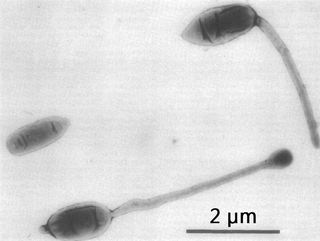Related Research Articles

The Moraxellaceae are a family of Gammaproteobacteria, including a few pathogenic species. Others are harmless commensals of mammals and humans or occur in water or soil. The species are mesophilic or psychrotrophic (Psychrobacter).

Archaeoglobaceae are a family of the Archaeoglobales. All known genera within the Archaeoglobaceae are hyperthermophilic and can be found near undersea hydrothermal vents. Archaeoglobaceae are the only family in the order Archaeoglobales, which is the only order in the class Archaeoglobi.

A diplococcus is a round bacterium that typically occurs in the form of two joined cells.
Moraxella is a genus of gram-negative bacteria in the family Moraxellaceae. It is named after the Swiss ophthalmologist Victor Morax. The organisms are short rods, coccobacilli, or as in the case of Moraxella catarrhalis, diplococci in morphology, with asaccharolytic, oxidase-positive, and catalase-positive properties. M. catarrhalis is the clinically most important species under this genus.
Moraxella bovis is a Gram-negative, aerobic, oxidase-positive diplococcus implicated in infectious bovine keratoconjunctivitis, an eye disease of cattle, also colloquially known as pinkeye or New Forest eye. M.bovis was first associated with cattle pinkeye in 1915 in Bengal, India
Moraxella osloensis is a Gram-negative oxidase-positive, aerobic bacterium within the family Moraxellaceae in the gamma subdivision of the purple bacteria.
Mesorhizobium tianshanense, formerly known as Rhizobium tianshanense, is a Gram negative species of bacteria found in the root nodules of many plant species. Its type strain is A-1BS.
Moraxella boevrei is a Gram-negative, oxidase- and catalase-positive, aerobic nonmotile bacterium in the genus Moraxella, which was isolated from the nasal flora of healthy goats in Lyon in France.
Moraxella caviae is a Gram-negative bacterium in the genus Moraxella, which was isolated from the pharyngeal region and mouth of guinea pig.
Moraxella cuniculi is a Gram-negative bacterium in the genus Moraxella, which was isolated from the oral mucosa of a rabbit in Germany. The previous name was Neisseria cuniculi.
Moraxella equi is a Gram-negative bacterium in the genus Moraxella, which was isolated from the eye of a horse.
Moraxella lincolnii is a Gram-negative bacterium in the genus Moraxella, which was isolated from the human respiratory tract.
Moraxella nonliquefaciens is a Gram-negative bacterium in the genus Moraxella, which was isolated from the upper respiratory tract of humans. M. nonliquefaciens occasionally causes disease.
Moraxella oblonga is a catalase- and oxidase-positive, Gram-negative bacterium in the genus Moraxella, which was isolated from the oral cavity of a sheep. Alysiella sp. was transferred to M. oblonga.
Moraxella bovoculi is a Gram-negative bacterium in the genus Moraxella, which was isolated from the eyes of calves in Browns Valley, California. M. bovoculi can cause infectious bovine keratoconjunctivitis.
Moraxella pluranimalium is a Gram-negative, aerobic, catalase- and oxidase-positive, non-spore-forming bacterium in the genus Moraxella, which was isolated from the nasal turbinate of a pig.
Moraxella porci is a Gram-negative, aerobic, catalase- and oxidase-positive, non-endospore-forming bacterium in the genus Moraxella, which was isolated from the brain of a pig suffering from meningitis.

Hyphomicrobium is a genus of Gram-negative, non-spore-forming, rod-shaped bacteria from the family of Hyphomicrobiaceae. It has a large polar or sub-polar filiform prostheca very similar to that of Caulobacter. In addition to having a nutritional function, the prostheca also plays a role in the initiation of DNA replication.
Rhodobium orientis is a phototrophic, Gram-negative, rod-shaped and motile bacterium species from the genus of Rhodobium which has been isolated from coastal seawater from Makurazaki in Japan.
References
- ↑ LPSN lpsn.dsmz.de
- ↑ Straininfo of Moraxella caprae
- ↑ Kodjo, A; Tønjum, T; Richard, Y; Bøvre, K (1995). "Moraxella caprae sp. nov., a new member of the classical Moraxellae with very close affinity to Moraxella bovis". International Journal of Systematic Bacteriology. 45 (3): 467–71. doi: 10.1099/00207713-45-3-467 . PMID 8590674.
- ↑ ATCC
- ↑ Taxonomy Browser
- ↑ George M. Garrity (24 November 2010). Bergey's Manual® of Systematic Bacteriology (2 ed.). Springer. ISBN 978-0387241449.